Lithium insertion in different TiO2 modifications
以偏钛酸为原料沉淀法制备纳米TiO2光催化剂
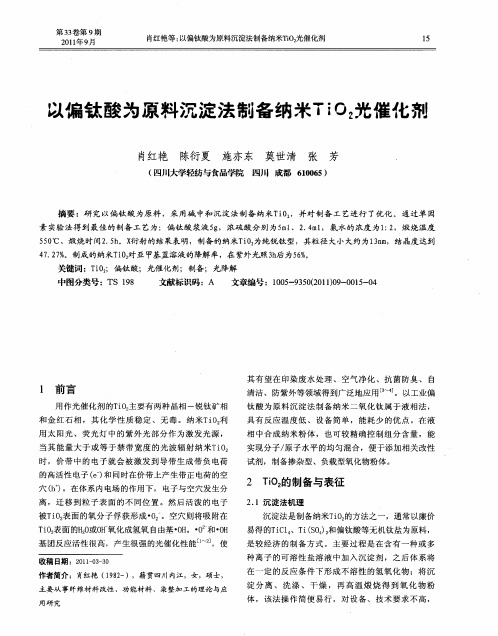
酸 ) l l 由于5 偏钛 酸中含有杂质 ,所 以按照 1 偏 = :, g 1 ( 钛 酸) n( : 浓硫 酸) 1 1 比例 不 能将 5 偏钛 酸 完全 = :的 g
溶 解 ,所 以应 该 加 大 浓硫 酸 的用 量 ,按 照 n( 钛 偏 酸) n 浓硫酸) :( 比例 为 12 :、 14 :、1 6 :、1 3 : 、1 5 : , 则对 应的浓硫酸用 量分别为2 4 L . m 、4 8 L . m 、3 6 L . m 、
摘要 :研 究以偏钛 酸为原 料 ,采 用碱 中和 沉淀 法制备 纳 米T 0,并对制 备 工艺进 行 了优化 。通 过单 因 i
素 实验 法得到 最佳 的制备 工艺 为:偏钛 酸浆 液5 ,浓硫 酸分别 为5 l . m ,氨 水 的浓度 为 1 2 g m 、2 4 l : ,煅烧温度 50 5 ℃、煅烧 时间2 5 。x . h 衍射 的结 果表 明 ,制备 的纳米T 0为纯锐钛型 ,其粒径 大小大约为1 n ,结晶度 达到 i m 3 4 . 7 。制成 的纳米T 0 亚 甲基 蓝溶液 的降解率 ,在 紫外光 照3后 为5% 72 % i 对 h 6。 关键词 :T 0;偏钛 酸;光催化 剂;制备 ;光降解 i
取5 偏钛酸 ( i (H 。 g T O O )),加入一定量浓硫 酸 ,
生成硫酸氧钛 ( i S T O 0)加热搅拌一段 时间使 反应完 全 ,然后 加入 一定 量 的蒸馏 水 ,使 其完 全溶 解 。继
续搅拌 3 m n 0 i ,加入活性 炭去除溶液 中的杂质 。抽滤 得 到澄清 溶液 ,缓 慢滴加 一 定浓度 的氨 水 ,至 p 约 H
鬻
肖艳: 钛为料淀制纳T 催剂 红等 偏酸原沉法备米O 化 以 i 2 光
tio2的实验报告

纳米TiO2的制备及其光催化性能的检验实验报告一、实验目的:1、了解纳米TiO2的性质及应用。
2、掌握制备纳米TiO2的原理和方法,并比较不同方法的优缺点。
3、掌握检验纳米TiO2光催化性能的一般方法。
4、掌握离心机、分光光度计等仪器的使用方法。
二、性质:(1)基本化学性质:纳米TiO2化学性能稳定,常温下几乎不与其它化合物反应,不溶于水、稀酸,溶于氢氟酸和热浓硫酸。
不与空气中CO2 ,SO2 ,O2等反应,具有生物惰性。
纳米TiO2具有热稳定性,无毒性。
与硫酸氢钾或与氢氧化碱或碳酸碱共同熔融成钛酸碱后可溶于水。
相对密度约4.0。
熔点1855℃。
(2)光催化:纳米TiO2是一种n型半导体材料,禁带宽度较宽,其中锐钛型为3.2eV,金红石型为3.0eV,当它吸收了波长小于或等于387.5nm 的光子后,价带中的电子就会被激发到导带,形成带负电的高活性电子e-,同时在价带上产生带正电的空穴h+,吸附在TiO2表面的氧俘获电子形成•O2-,而空穴则将吸附在TiO2表面的OH-和H2O氧化成具有强氧化性的•OH,反应生成的原子氧、氢氧自由基都有很强的化学活性, 氧化降解大多数有机污染物,同时空穴本身也可夺取吸附在半导体表面的有机物质中的电子,使原本不吸收光的物质被直接氧化分解,这两种氧化方式可能单独起作用也可能同时起作用,对于不同的物质两种氧化方式参与作用的程度有所不同。
这些原子氧、氢氧自由基和空穴还能与细菌内的有机物反应,生成CO2、H2O 及一些简单的无机物,从而杀死细菌,清除恶臭和油污。
此外,半导体表面产生的高活性电子具有很强的还原能力,电子受体可直接接受光生电子而被还原, 故也可用来还原去除环境中的某些特定污染物,如: Cu2+等有毒离子。
另外,光催化效率与激发态电子、空穴到达表面的时间有关, 纳米TiO2粒子作为光催化剂, 其粒径越小,电子、空穴到达反应表面的数量越多,光催化效率越高但是,由于TiO2本身禁带宽, 产生的电子-空穴对不仅极易复合而且寿命较短, 光响应范围较窄, 使光催化活性受到了一定的限制,且利用的光谱范围受到一定的限制。
间苯二酚在TiO2-石墨烯修饰玻碳电极上的电化学行为及测定
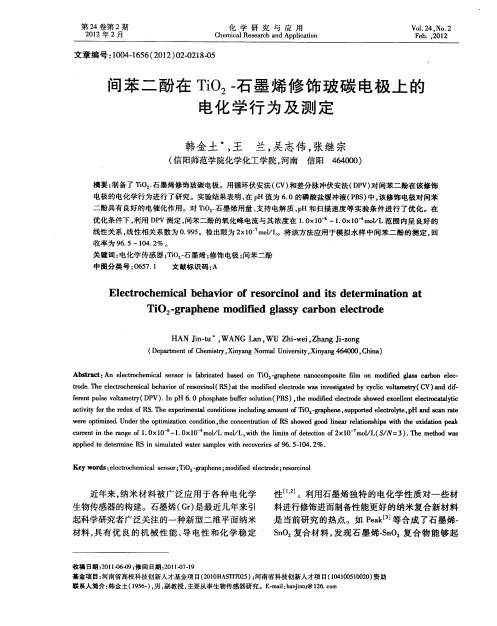
酚的灵敏检测对于研究酚 的环境行为 、 态效应 生 和致 毒机 理具 有重 要 意义 。 间苯二 酚 的分 析方 法主要 有 高效 液相 色谱 法 , 分 光 光 度 法 ] 和 。然 而 , 这些 方 法 大 多 步
骤烦 琐 、 时 长 、 受 其 他 物 质 的干 扰 , 大 多 需 耗 易 且 要 大型仪 器 、 价格 昂贵 。相 比其 他 方法 , 电化 学 法
c re ti h a g f1 0 0 6 u r n n t e r n e o . xl - 1 0 l mo Lm lL wt el t o eet no 2 1 mo L S N= ) T em to a xO l o , ht mi f t i f x 0 / / i h i s d co l (/ 3 . e d w s / h h
间苯 二 酚 在 i2 石 墨 烯 修 饰 玻碳 电极 上 的 TO 一 电化 学 行 为 及 测 定
韩金土 , 王 兰 , 志伟 , 吴 张继 宗
( 信阳师范学院化学化工学院, 河南 信阳 440 ) 600
摘要 : 制备 了 TO 一 墨烯 修饰玻碳电极。用循 环伏安法 ( V) i 石 c 和差分 脉冲伏 安法( P 对 间苯二 酚在该修饰 D V)
近年 来 , 米 材 料 被 广 泛 应 用 于 各 种 电化 学 纳
性 。利 用石 墨 烯 独 特 的 电化 学 性 质 对 一 些 材
生物传感器的构建 。石墨烯( r是最近几年来引 G) 起科 学研 究者 广泛 关 注 的一 种 新 型 二维 平 面 纳 米
材料 , 有 优 良 的 机 械 性 能 、 电 性 和 化 学 稳 定 具 导
F g 1 S M ma e o i - i. E i g fT O2 Gr
细胞色素c在TiO_2纳米粒子表面的增强拉曼光谱研究
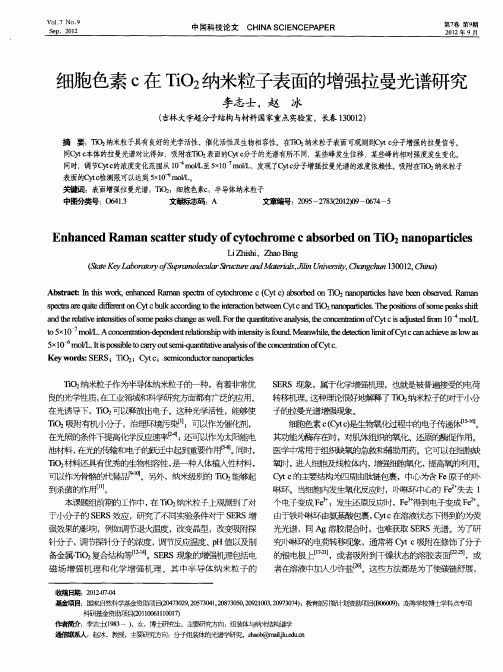
基金项目:国家自然科学基金资助项目 92534, 835,0203293 7) 教育部引智讨戈喷 助项 ̄(009; '07o 12 7002910 ,0704; 0 B 60) 高等学校博士学科点专项 利移瞎 金资助项目C l o 11o7 2 1 610l) 0O
作者简介: 李志士( 8 一 ) 女, 13 , 9 博土研究生, 主要研究方向: 组装体与纳米 结 喾 学 通信联系 ^ 赵冰,教 : 授,主要 碗 分子组装体的 向: D◎ 砌 .. l】 b j 。 h ca 1h
I 实 验
1 样品与试剂 . 1
C t 购 自 A rs l n s yC c Og i 公司 ,未进—步纯化 。钛酸 四 o ac
的拉曼光谱测试条件为 3 采样次数为 1 0, S 次。
21 T 2 . i 纳米粒子的 性质 0
丁酯
, 无水乙醇c ./ , 9 50 硝酸( %) l o) 9 7 和其他化学品购自 0
En a c d Ra a c te u yo t c r m eca s r e n Ti a o ri ls h n e m n s a t rs d f y o h o b o b d o 02 n pa t e t c n c
L Zhs i Z a i i , h onig h n
细胞色素cC t) (yc 是生物氧化过程中的电子传递体【 J J 。 b
其功能为酶存在时 , 对肌体组织的氧化、还原的酶促作用。
池材料 , 在光的传输和电子的跃迁中起到重要作用[]同时, 5。 - 8 TO 材料还具有优秀的生物相容陛, i2 是一种 ^ 体植 ^ 性材料,
可以作为骨骼的代替品 。另外 ,纳米级别的 T 2 i 能够起 0
离子液体中制备纳米TiO2/纤维素复合纤维及产物的光催化性能
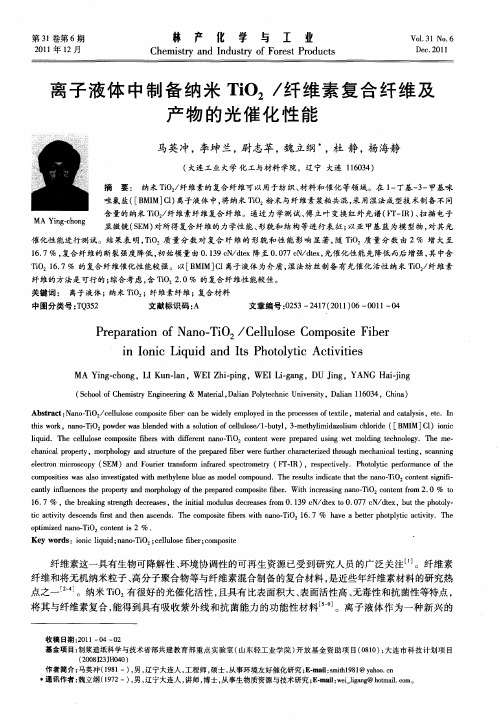
ti w r , aoTO o dr a l d dwt lt no l ls 1btl 3m ty mdzl m clr e( B M] 1 oi h ok nn—i 2 w e s e e i as ui f e uoe 一uy, - e l iao u ho d [ M1 C )in s p w bn h o o cl / hi i i c
第 3 卷第 6期 1 21 年 1 01 2月
林 产 化 学 与 工 业
Ch mity a d I d sr fFo e tPr d cs e sr n n u t o r s o u t y
Vo . 1 No 6 13 . D c2 1 e . 01
P e a a in o n — O2 r p r t fNa o Ti /Ce l l s mp st i e o l o e Co o ie F b r u
i o i iu d a d IsP ooyi t i e n In c L q i n t h tlt Aci t s c vi
} 通讯作者 : 魏立纲 (9 2一 , , 17 ) 男 辽宁大连人 , 讲师 , 博士 , 事生物质 资源 与技术研究 ; ・ a :e l ag o a .o 。 从 E m i w i i n @h t i cm l —g m l
1 2
林
产
化
学
与
工
业
第3 1卷
溶 剂 以其 良好 的溶 解性 能 , 稳定 性 , 来越 被人 们关 注 。20 热 越 0 2年 ,wt si S aok 等首 先发 现纤维 素无 需 l 活 化可 以直 接溶解 在室 温离 子 液体 中… 为纤 维 素 新 溶 剂体 系 的研 究 开辟 了新 领 域 , 。作 者将 纳 米 TO 加 入 均相纤 维素 离子 液体 ( B M] 1溶 液 中制备 纳 米 TO/ 维 素纤 维 复 合 材 料 , 对 材料 i [ MI c ) i 纤 并
白藜芦醇负载的TiO_2纳米管阵列抑制炎症反应促进骨修复及其机制的研究
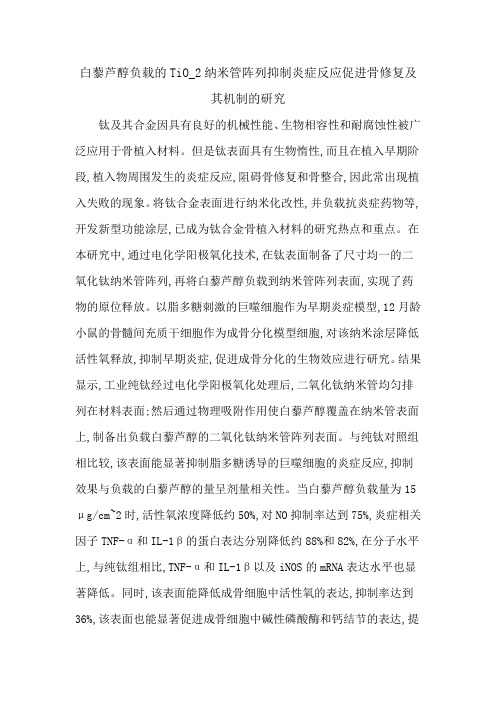
白藜芦醇负载的TiO_2纳米管阵列抑制炎症反应促进骨修复及其机制的研究钛及其合金因具有良好的机械性能、生物相容性和耐腐蚀性被广泛应用于骨植入材料。
但是钛表面具有生物惰性,而且在植入早期阶段,植入物周围发生的炎症反应,阻碍骨修复和骨整合,因此常出现植入失败的现象。
将钛合金表面进行纳米化改性,并负载抗炎症药物等,开发新型功能涂层,已成为钛合金骨植入材料的研究热点和重点。
在本研究中,通过电化学阳极氧化技术,在钛表面制备了尺寸均一的二氧化钛纳米管阵列,再将白藜芦醇负载到纳米管阵列表面,实现了药物的原位释放。
以脂多糖刺激的巨噬细胞作为早期炎症模型,12月龄小鼠的骨髓间充质干细胞作为成骨分化模型细胞,对该纳米涂层降低活性氧释放,抑制早期炎症,促进成骨分化的生物效应进行研究。
结果显示,工业纯钛经过电化学阳极氧化处理后,二氧化钛纳米管均匀排列在材料表面;然后通过物理吸附作用使白藜芦醇覆盖在纳米管表面上,制备出负载白藜芦醇的二氧化钛纳米管阵列表面。
与纯钛对照组相比较,该表面能显著抑制脂多糖诱导的巨噬细胞的炎症反应,抑制效果与负载的白藜芦醇的量呈剂量相关性。
当白藜芦醇负载量为15μg/cm~2时,活性氧浓度降低约50%,对NO抑制率达到75%,炎症相关因子TNF-α和IL-1β的蛋白表达分别降低约88%和82%,在分子水平上,与纯钛组相比,TNF-α和IL-1β以及iNOS的mRNA表达水平也显著降低。
同时,该表面能降低成骨细胞中活性氧的表达,抑制率达到36%,该表面也能显著促进成骨细胞中碱性磷酸酶和钙结节的表达,提高成骨分化相关因子ALP、OCN、OPN、COL-1和Runx2的上调,而且TNT-Res成浓度依赖性降低了巨噬细胞和成骨细胞中NF-κB的磷酸化水平。
以上结果表明,经过阳极氧化和负载白藜芦醇后的钛材料可以通过抑制NF-κB信号通路的激活来显著抑制早期炎症反应,促进成骨分化,TNT-Res(Resveratrol-Titanium dioxide nanotubes)可能是提高骨整合能力的有效植入物。
Investigation of lithium extraction and insertion from LiCoPO4 by in situ X-ray and neutron diffract
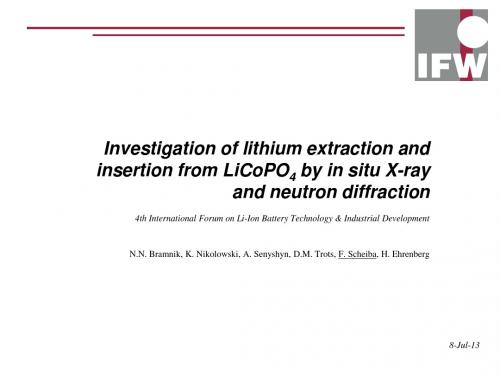
Institute for Materials Science
Darmstadt
Tight collaboration with the structural research group at the Institute for Materials Science (Darmstadt)
N.N. Bramnik, K. Nikolowski, A. Senyshyn, D.M. Trots, F. Scheiba, H. Ehrenberg
8-Jul-13
Leibniz-Institut für Festkörper- & Werkstoffforschung
Leibniz Institute for Solid State and Materials Research
Situated in the heart of Europe (Dresden, Germany)
Leibniz-Institut für Festkörper- & Werkstoffforschung
Leibniz Institute for Solid State and Materials Research
0
4.71
-0.04
4.5
4.78
4.6
4.7
4.8
4.9
5.0
E, V vs Li/Li+
LiCoPO4 – In situ X-ray diffraction
200 LixCoPO4 <x>~0.4 020 311
discharge
以花瓣为模板制备TiO_2分层介孔纳米片

综上所述 , 本文以月季花花瓣为模板 , 在钛酸四丁酯前驱体的溶液 中浸渍后于 5 0o 下煅烧 , 0 C 成
功 制备 了具 有原 模板 形貌 特征 且能 反 映原始 模板 分层 多级 多孔 结构 的 TO 纳米 薄片 .所得 TO 具有 薄 i i:
的片层 结 构 ( 度 4 n 和均匀 的孔 道结 构 ( 厚 m) 尺寸 4n , 强 了捕 捉光 的能力 .较薄 的 片层 结构 及煅 m) 增
层 结构 有关 ,这些 特殊 的纳米 结 构使样 品可 以大量 吸收 可见 光 .与 P5相 比,仿 生 TO 纳米 薄 片 的吸 2 i: 收边红 移 了约 2 m, 带宽 度也 相应 减小 ,这可 能是 由于仿 生 材 料 的独 特结 构 以及 生 物 模板 煅 烧 后 0n 禁
遗 留下 来 的少量 氮元 素 引起 的氮掺 杂造 成 的 .E S能谱 测试 结果 中氮元日 嚣的存在 证实 了这一 判断 . D 素 一 暑 占 一 0
∞ ∞ ∞ ∞ ∞ ∞ ∞ ∞ ∞ 加 ∞ 0
2n /m
Fi . UV- s DRS s e t a o i m o p c Ti g7 Vi p c r f b o r hi o2
F g 8 P o o a a y i c i i fb o r h c Ti i . h t c t l t a tvt o i mo p i O2 c y
N . o3
赵 晓兵 等 :以花 瓣 为 模 板 制 备 TO i 分 层介 孔 纳 米 片
构 .发达 的孔 结构 有利 于 吸附污 染物 ,为 TO 的光催 化提 供 了 高浓 度有 机 环境 , 而 提 高 了光 催 化 活 i: 进 性 并加 快 了反应 速 度.
染料敏化太阳能电池TiO2薄膜的制备方法
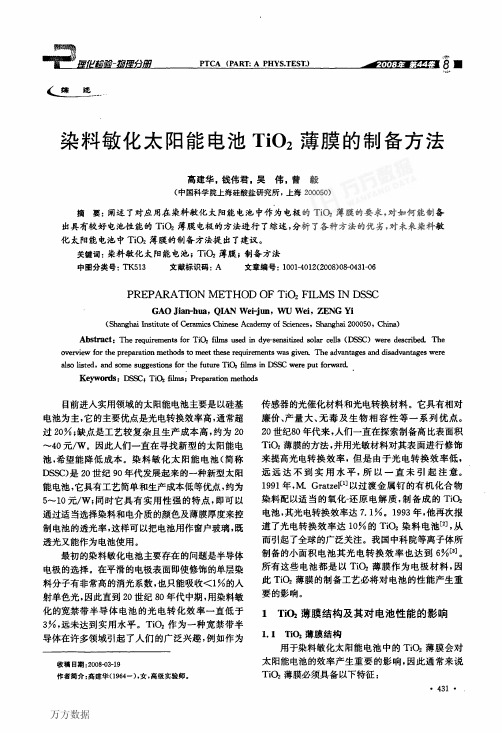
然后加入聚乙二醇作为表面活性剂即可得到稳定的 或者NazS04即可得到纯锐钛矿型Ti02溶胶。
纯锐钛矿纳米溶胶。
Peng and Chen等[22]在高温下将干净的金属钛片浸
另外还可采用四氯化钛水解后进行水热处理, 泡在丙酮溶液中,以丙酮为氧化源可以制得致密和
通过控制前驱体的合成条件可以得到不同显微结构 和均质稳定的纳米氧化钛胶体。同钛醇盐相比, TiCL是种相对较便宜的原料。因此一直有人利用
·434·
6.67%的电池。 (3)激光烧蚀溅射沉积法 激光烧蚀技术是近年来新发展的一种薄膜制备
万方数据
笮獭:盈狴雠二堑鲤幽
壹垄生篁!鲞塾丝垡查堕丝皇垄!!垒蔓壁竺型鱼查鲞
(1)足够大的比表面积,以尽可能多地吸收染 料分子。例如10弘m厚的Ti02薄膜(Ti02平均粒 径为15~20 nm)在吸附了染料后能使比表面积增 加1 000倍,从而使TiOz电极在最大吸收波长附近 捕获光的效率达到近100%。
可以得到粒径为14不n同m的 晶相和尺寸的Ti02凝胶。如Barbe 为70 ms,而 采m用o粒l径/为L32
得的薄膜其复合 时间仅为18 ms。电子复合时间的
延长意味着光生 电子在薄膜内传输效率的提高,因
此存在一个最佳的Ti02粒径以获得最大的光电转
以锐钛矿为主,还存在少量金红石以及板钛矿的 nHmN03 的T酸iO性z条颗件粒下制能备得所到 等[12]发现,在o.1Ti02颗粒制备的薄膜其复合时间
(3)通常应是锐钛矿相。Park N-G等[司的研 究表明,同样厚度的锐钛矿型Ti02薄膜的比表面 积比金红石型Ti02薄膜大25%;对染料的吸收量 多35%;具有相似的Fy特性;短路电流高30%。
(4)薄膜表面应当无宏观裂纹和其他明显缺 陷,以保证光生电子在薄膜内部快速并有效地传递。 1.2 Ti02薄膜结构对电池性能的影响
具有不同Bi_Ti摩尔比的BiOI_TiO_2_A_光催化剂的结构与性能-中英文对照
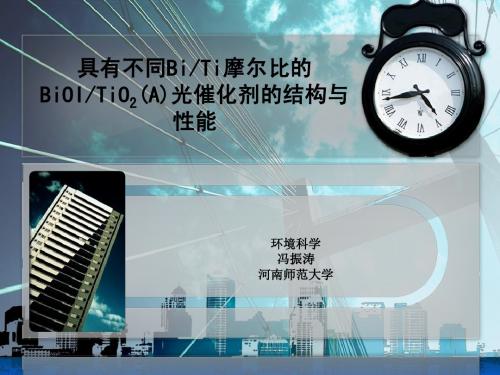
1.简介
Hale Waihona Puke Anatase TiO2 (A) has been widely used as a photocatalyst forsolar energy conversion and degradation of environmental pollutantsbecause of nontoxicity, chemical stability, good photoactivity,and low cost.1-9 However, the intrinsic property of TiO2(A) (wide band-gap energy, ~3.2 eV) limits its photocatalyticactivity in the UV light region. In order to extend TiO2 (A) photocatalyticactivity into the visible light region, some attemptshave been made to sensitize TiO2 (A).10-14 Among these attempts,CdS is widely studied as an efficient sensitizer to makeTiO2 (A) response visible light, but it is prone to decomposeand leach out hazardous Cd2 + ions under photocatalytic reactionsystems.
锐钛矿TiO2(A)由于其无毒、化学性质稳定、光活性高以及价格低廉被广泛的用作太阳 能转化降解环境污染物的光催化剂。然而,二氧化钛的本征性质(带隙较宽,~3.2eV)限 制了它在紫外光区的光催化活性。为了将TiO2(A)的光催化活性扩展到可见光区,我们 进行了一些敏化TiO2(A)的尝试。在这些尝试中,CdS作为使TiO2(A)在可见光区反 应的敏化剂被广泛研究,但是它要求在光催化反应系统中分解萃取出Cd2+。
二氧化钛

纳米二氧化钛 纳米粉体是指颗粒粒径小于 100nm 的 粒子。 纳米二氧化钛不但具有纳米粉体的 表面效应、体积效应、小尺寸效应、 久保效应等,而且具有其独特的性 能。因此具有广阔的应用前景。
性能 TiO2%(最小) 密度/(g/cm3) 表面积/(m2/g) 类型Ⅰ 97 4.20 6.6-7.7 类型Ⅱ 93 4.05 12.0-12.8 19 30 3.5 中等 类型Ⅲ 92 4.05 11.0-18.0 15-19 30 3.6 中等 类型Ⅳ 91 4.00 17.7 24 35 4.9 高 类型a b 82 3.70 28.8 30 55 13.0 低
Task:寻找2013.08发布在JACS的有关二氧化钛文章, 翻译其摘要并介绍二氧化钛的相关知识。
主讲人:高恩鹏 韩晓妮 海红莲 小组成员:高恩鹏 韩晓妮 海红莲 王变变
Lithium Insertion into Titanium Dioxide (Anatase): A Raman Study with 16/18O and 6/7Li Isotope Labeling
缺点
因经过重结晶,所以制得的粉体纯度高。水热法合 成 TiO2的关键问题是设备要经历高温、高压,因 而,对材质和安全要求较严,操作复杂,而且成本 较高。
固相法
固相法合成纳米二氧化钛是利用固态 原料热分解或固-固反应进行的。主 要有惰性气体蒸发原位加压制备法、 非晶晶化法、溶胶-凝胶法、电解沉 淀法、高速超微粒子沉淀法、直接沉 淀法、烧结-锻压法、反应球磨技术 等。
二氧化钛胶粒嵌入超细层状钛酸盐制备金红石型氧化钛纳米纤维(中英文混合版)
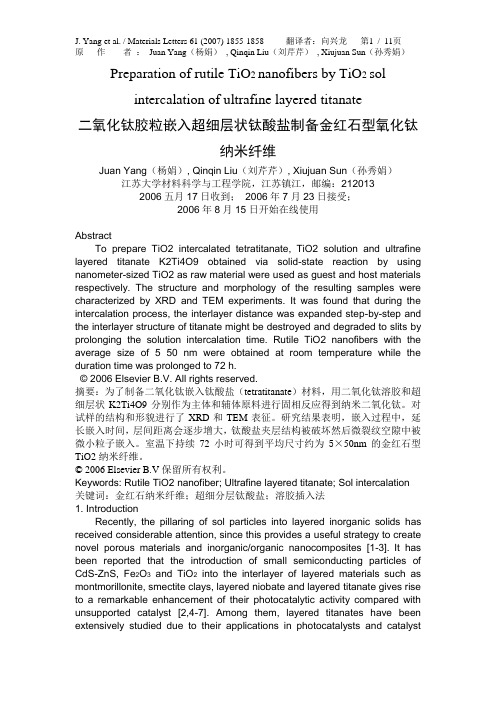
Preparation of rutile TiO2 nanofibers by TiO2 solintercalation of ultrafine layered titanate二氧化钛胶粒嵌入超细层状钛酸盐制备金红石型氧化钛纳米纤维Juan Yang(杨娟), Qinqin Liu(刘芹芹), Xiujuan Sun(孙秀娟)江苏大学材料科学与工程学院,江苏镇江,邮编:2120132006五月17日收到;2006年7月23日接受;2006年8月15日开始在线使用AbstractTo prepare TiO2 intercalated tetratitanate, TiO2 solution and ultrafine layered titanate K2Ti4O9 obtained via solid-state reaction by using nanometer-sized TiO2 as raw material were used as guest and host materials respectively. The structure and morphology of the resulting samples were characterized by XRD and TEM experiments. It was found that during the intercalation process, the interlayer distance was expanded step-by-step and the interlayer structure of titanate might be destroyed and degraded to slits by prolonging the solution intercalation time. Rutile TiO2 nanofibers with the average size of 5×50 nm were obtained at room temperature while the duration time was prolonged to 72 h.© 2006 Elsevier B.V. All rights reserved.摘要:为了制备二氧化钛嵌入钛酸盐(tetratitanate)材料,用二氧化钛溶胶和超细层状K2Ti4O9分别作为主体和辅体原料进行固相反应得到纳米二氧化钛。
2023年LITHIUM电池危险品包装检查清单跟踪标记-日期说明书

DIRECTIONS: Mark the appropriate box for each item to indicate if the shipment complies with the requirement. Check all sides of the package, as applicable.1. Shipment acceptable by both origin and destinationlocations. [eSRG]2. Package in good condition and free of leakage, odor,or external damage. [5.0.2.4.1; 9.1.3.1 (i)]3. Lithium batteries not shipped in same package as Class1.4,2.1, 3, 4.1, 4.2, 4.3, 5.1, 5.2 and 8 and 2.2 withCargo Aircraft Only label, including All Packed in One andOverpack. [FX-05 (b)]4. Shipper’s declaration included. [8.0.1] Typewritten orcomputer-generated per FX-07.ON THE SHIPPER’S DECLARATIONTracking number must be completed by DG Specialist (if not already completedby Shipper). Shipper must provide 3 copies in English and at least 2 copies withred hatchings. [8.1.6.3; FX-08]5. Shipper’s Declaration prepared per FX-18 (does notapply to 023 shipments or shipments originating in U.S.territories or non-U.S. locations).Y N N/A6. Shipper and Consignee name and full address. For023 shipments, shipper’s address includes country name.[8.1.6.1; 8.1.6.2]7. Page of Pages. [8.1.6.4]8. Passenger and Cargo Aircraft or Cargo Aircraft Onlylimitations correctly indicated. UN 3090 and UN 3480must be Cargo Aircraft Only. [8.1.6.5; PI 965; PI 968]NOTE: S.P. A88 and A99 must be Cargo Aircraft Only.9. Non-radioactive correctly indicated. [8.1.6.8]10. UN number preceded by prefix “UN”. [8.1.6.9.1, Step 1]11. Proper Shipping Name. [8.1.6.9.1, Step 2]12. Class 9 indicated. [8.1.6.9.1, Step 3]13. Packing Group left blank on declaration. [8.1.6.9.1, Step5]14. Number of packages and type of packaging (e.g., 1fibreboard box, 1 box fibreboard or 1 4G fibreboard box).[8.1.6.9.2, Step 6]15. Net quantity per package (in metric units) not exceedingPacking Instruction maximum per package, unlessallowed by special provision. [8.1.6.9.2, Step 6 (a); A88;A99]16. Packing Instruction number. [8.1.6.9.3, Step 8]NOTE: If A88 in the Authorization field, then PI is 910. IfA99 in the authorization field, then PI is 974.17. Shipment complies with special provisions. [IATA 4.2,column M]NOTE:A802 does not apply to UN3090 IB and UN3480IB shipments.Y N N/A18. 24-hour emergency response telephone number,including international prefix, if required by State orOperator variation. [2.8]Y N N/A19. Name, date, and shipper’s signature (signature may betypewritten for U.S. domestic shipments, including U.S.territories). [8.1.4.1; 8.1.6.13-14]20. Shipper’s same signature next to amendments andalterations (changes). [8.1.2.6]NOTE: An insertion in different handwriting or printing is not considered to be an alteration. Y N N/APACKAGINGVerify the outer packaging used is compliant with the packing instructionnumber indicated on the Shipper’s Declaration. Handwritten Specificationmarkings unacceptable. [5.0.1.2 (b)]21. Number and type of packaging correspond todeclaration (not including Overpack). [9.1.3.1 (g)]22. Package large enough to support all markings, labels,documentation and none are placed on bottom ofpackage. FedEx branded packaging (including brownboxes) not used.[FX-06]23. Package permitted by Packing Instruction and inspecification packaging, if required. [5.0.1.2 (b)]NOTE: PI 966 and 969, UN specification may be inner orouter packaging. A88/A99 - see FedEx ApprovalLetter.Y N N/A24. packaging: Performance rating (X or Y). Handwrittenspecification markings unacceptable. [6.0.4.2 (c); 6.0.4.1Note]NOTE: Packing Instruction 910 require ‘X’ PerformanceRating.Y N N/A25. Specification Packaging with S:4G/X35/S/22/C222Enter UN Specification weight limit: _____________ kg(Max weight as listed within the UN Specification marking;e.g. 4G/X35/S/22/C222)Enter actual package gross weight:_____________ kg(T otal weight of the package from airbill or package label)Actual package gross weight DOES NOT EXCEED UNspecification weight limit (not required for Overpack).[6.0.4.2.1 (d)]N/AMARKING AND LABELING(Markings and labels correspond to shipper’s declaration and must be durablyaffixed.) [7.1.3.2 (a); 7.2.126. Shipper and Consignee name and full address markedon package. [7.1.4.1 (b)]27. UN number preceded by prefix “UN”, meets sizerequirements and corresponds to declaration.[7.1.4.1 (a); 7.1.4.4]NOTE: UN number on lithium battery mark meets thisrequirement.28. Proper Shipping Name and corresponds todeclaration. [7.1.4.1 (a)]29. Shipments with more than one package: Net quantitymarked on package. Not applicable when contents aresame UN #, PSN, packing group, and quantity. [7.1.4.1(c)]Y N N/A30. Class 9 Lithium Battery label on same surface andin diamond shape as Proper Shipping Name markingwhen package dimensions are adequate. [7.2.3.9.1;7.2.6.2; 7.2.6.2.5; 7.3.X]31. Cargo Aircraft Only label affixed on same surface ofpackage near hazard label(s), when required. UN3090 andUN3480 must be Cargo Aircraft Only. [7.2.4.2; 7.2.6.3]Y N N/A32. Markings and label(s) meeting IATA specifications,correctly applied (not obscured or covering requiredmarkings, not folded or wrapped on more than one faceof package); irrelevant or contradictory markings/labelsremoved or obliterated. [7.1; 7.2; 7.3]Special Provision A88/A99: Shipper on FedEx ExpressA88/A99 Approval list. [FX-05 (a)]34. Competent Authority approval document(s) attachedto package and not expired. (e.g. Competent Authority [CA], DOT-SP, etc.) [A88; A99]35. FedEx Approval Letter attached to package and023 air waybill : Correct statements, as appropriate, inHandling Information box. [8.2.1; 8.2.2]Y N N/A43. Complies with all other applicable State and Operator variations . [2.8]44.Specification Packaging to/from/within Brazil - Shipment complies with BRG-05:• Specification Packagings manufactured in Brazil must have ANAC’s packaging certificate of approval and the conformity declaration issued by the packaging manufacturer.• Specification Packagings not manufactured in Brazil must have a package certificate of approval or any equivalent document issued by other civil aviation authorities or national authorities.NOTE : Applicable to shipments in Specificationpackaging only.YNN/ACOMMENTS: __________________________________________________________________________________________________________________________________________________________________________________________________________________________________________________________________________________________________________________________________________________________________________________________________________________________________________________________________________________________If there are any discrepancies indicated, your shipment cannot be transported by FedEx Express. In the U.S., this shipment is returned to the Shipper using DOT-SP 14691. In the U.S., call 1.800.GoFedEx and press “81” then “4” for assistance. For non-U.S. locations, please contact your local Customer Service representative.Printed or other static representations of this document are considered uncontrolled and for reference only.ACCEPTEDREJECTEDInspected By __________________________________________Employee # __________________________________________Shipper Contact Name __________________________________Shipper Contact Phone # ________________________________。
液相合成纳米二氧化钛

Solution-Phase Synthesis of Titanium Dioxide Nanoparticles and Nanocrystals
Matteo Cargnello,† Thomas R. Gordon,† and Christopher B. Murray*,†,‡
© XXXX American Chemical Society
Special Issue: 2014 Titanium Dioxide Nanomaterials Received: March 27, 2014
A
/10.1021/cr500170p | Chem. Rev. XXXX, XXX, XXX−XXX
†
Department of Chemistry and ‡Department of Materials Science and Engineering, University of Pennsylvania, Philadelphia, Pennsylvania 19104, United States as high thermal and chemical stability, make it one of the most employed materials in pigments, UV sunscreens, cosmetics, medical implants, and sensors.1 In addition to these traditional applications, titania is being employed in many other emerging applications including optoelectronics, photovoltaics, catalysis, fuel cells, batteries, smart windows, and self-cleaning and antifogging surfaces. It is also the most heavily investigated wide band gap semiconductor for photocatalytic and photoCONTENTS electrocatalytic processes, which have gained increased interest 1. Introduction A in recent years within the scientific community.2 2. General Principles for Synthesis of Titania Titania particles and structures possessing small particle and Particles D feature size (below 100 nm) can show high visible light 2.1. Solution-Phase Synthesis of Uniform Partransparency combined with high UV light absorption, and in ticles D some cases they display iridescence.3 Small nanoparticles can 2.2. Surfactants and Protecting Ligands E also enhance the adsorption coefficients of organic molecules 3. Titanium Precursors F adsorbed on their surfaces.4 In addition, altering the size, as well 3.1. Titanium Alkoxides F as the shape, of titania nanoparticles has been shown to 3.2. Titanium Halides (TiCl4 and TiF4) F strongly influence the adsorption of molecules and the rate of 3.3. Titanatranes G electron transfer events at the particle surface, which has 3.4. Titanium Metal and Carboxylate-Derived potentially important implications for a variety of applications, Compounds G including catalysis. As a result, titania particles in the size 3.5. Titanium(IV) Bis(ammoniumlactato) Dihydrregime 1−100 nm are very interesting for a variety of oxide G technological applications, and the synthesis of well-controlled 3.6. Titanium Sulfate and Oxysulfate G titania nanostructures is important in order to impart the 3.7. Oxobis(2,4-pentanedionato-O,O ′)titanium desired characteristics to the final material. Particle size, shape, [TiO(acac)2] G and phase are critical in determining the final properties of the 4. Aqueous Methods G nanoscale materials. 4.1. Sol−Gel Methods G Among the many methods used to prepare nanoparticles and 4.2. Hydrothermal Methods J nanostructures, a primary classification can be made by 5. Nonaqueous Methods O distinguishing physical and chemical methods. Physical 5.1. Solvothermal Methods O methods usually rely on top-down approaches in which small 5.2. Nonhydrolytic Methods R structures are fabricated from larger ones. In contrast, chemical 6. Templated Approaches U methods most commonly proceed through a bottom-up 6.1. Soft Templates V approach, in which molecular precursors react to form the 6.2. Hard Templates W final larger structures. Both methods have advantages and 7. Summary and Perspectives W disadvantages: physical methods can produce large quantities of Author Information X material (e.g., the preferred methods in the electronic industry Corresponding Author X are physical methods) but their resolution is limited to tens of Notes X nanometers. Chemical methods, on the other hand, are Biographies X typically performed at a smaller scale in which the precision Acknowledgments X during the preparation of small (e.g., <100 nm and often <10 References X nm) structures can approach the atomic-layer limit.5 Wet chemical or solution-phase methods, in particular, are best suited to achieve the finest control over particle size, shape, and composition as desired for several of the above-mentioned 1. INTRODUCTION Titanium dioxide or titania (TiO2) is one of the most abundant compounds on our planet and a very appealing material for a variety of applications. Unique physical and chemical characteristics combined with earth abundance and nontoxicity, as well
TiO2的制备与表征方法

TiO2的制备与表征方法在研究与应用中,纳米材料的制备方法也越来越多、越来越先进。
制备TiO2我们现在通常有一下几种方式:溶胶-凝胶法、气相沉积法、水热和溶剂热法、静电纺丝法等。
其中,静电纺丝法是一种相对比较简单的制备一维纳米材料的方法[5]。
而为了对制备样品的观察,我们使用Raman、X射线衍射(XRD)、扫描电子显微镜(SEM)、透射电子显微镜(TEM)来进行表征。
接下来我们就具体的来介绍下TiO2的制备和表征方法。
2.1静电纺丝法制备TiO22.1.1关于静电纺丝法1)静电纺丝法的原理静电纺丝法属于纤维制造工艺,在强电场的作用下,聚合物溶液或熔体进行喷射纺丝,针头处液滴会由球形变为称为“泰勒锥”的圆锥形,并延展为纤维细丝。
这是一种生产纳米级直径的聚合物细丝的方法。
而聚合物的分子量和结构、电动势大小、管屏距、喷口形状、温度、湿度等都对静电纺丝法产生影响。
图2.1 静电纺丝法实验装置2)静电纺丝法的现状和应用因其制造装置简单、成本低、可纺物质多、工艺可控等优点,静电纺丝法成为了制备纳米纤维材料的主要方法。
但是它还存在所得产品性能研究不完善、大多产品仅处于实验阶段、产业化生产问题大等问题。
其主要应用在:生物医用材料、过滤、催化、化妆品、汽车玻璃等方面。
2.1.2用于制备TiO的高压静电纺丝法2用高压静电场对高分子溶液的击穿作用来制备纳微米纤维材料的方法被称为高压静电纺丝技术。
其基本原理是把上万伏的静电场施加在喷射和接收装置之间,纺丝液的锥端就会形成射流,并在电场中被拉伸,无纺状态的纳米纤维就在接收装置上形成了。
2.1.3高压静电纺丝法的装置高压静电纺丝法的装置包括基座、高压电源、喷头和接受装置(如下图)。
图2.2高压静电纺丝法实验装置1)基座起到固定和连接作用。
2)高压电源在喷头和接收装置之间施加一个达到1~4KV的高压电场。
在我们制备TiO2的实验中我们使用的是高压直流电源。
3)喷头注射器、塑料管、金属管等都可以用来当做喷头,形成小液滴从而产生流射是其目的。
表面活性剂对TiO2纳米颗粒的形貌、大小和光催化活性的调控
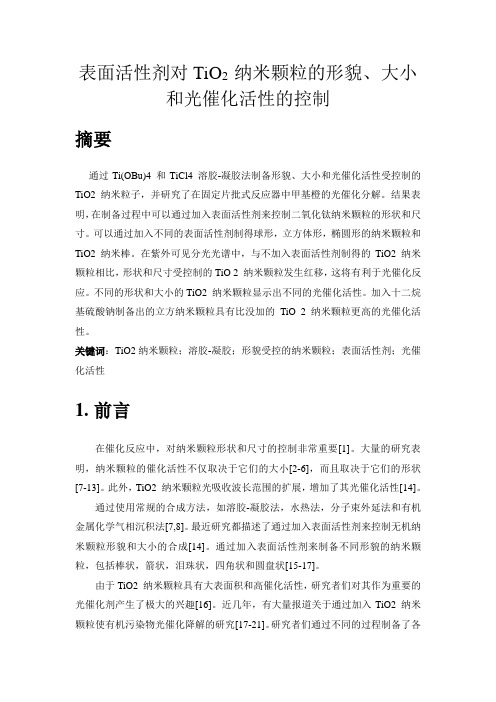
表面活性剂对TiO2 纳米颗粒的形貌、大小和光催化活性的控制摘要通过Ti(OBu)4 和TiCl4 溶胶-凝胶法制备形貌、大小和光催化活性受控制的TiO2 纳米粒子,并研究了在固定片批式反应器中甲基橙的光催化分解。
结果表明,在制备过程中可以通过加入表面活性剂来控制二氧化钛纳米颗粒的形状和尺寸。
可以通过加入不同的表面活性剂制得球形,立方体形,椭圆形的纳米颗粒和TiO2 纳米棒。
在紫外可见分光光谱中,与不加入表面活性剂制得的TiO2 纳米颗粒相比,形状和尺寸受控制的TiO 2 纳米颗粒发生红移,这将有利于光催化反应。
不同的形状和大小的TiO2 纳米颗粒显示出不同的光催化活性。
加入十二烷基硫酸钠制备出的立方纳米颗粒具有比没加的TiO 2 纳米颗粒更高的光催化活性。
关键词:TiO2纳米颗粒;溶胶-凝胶;形貌受控的纳米颗粒;表面活性剂;光催化活性1.前言在催化反应中,对纳米颗粒形状和尺寸的控制非常重要[1]。
大量的研究表明,纳米颗粒的催化活性不仅取决于它们的大小[2-6],而且取决于它们的形状[7-13]。
此外,TiO2 纳米颗粒光吸收波长范围的扩展,增加了其光催化活性[14]。
通过使用常规的合成方法,如溶胶-凝胶法,水热法,分子束外延法和有机金属化学气相沉积法[7,8]。
最近研究都描述了通过加入表面活性剂来控制无机纳米颗粒形貌和大小的合成[14]。
通过加入表面活性剂来制备不同形貌的纳米颗粒,包括棒状,箭状,泪珠状,四角状和圆盘状[15-17]。
由于TiO2 纳米颗粒具有大表面积和高催化活性,研究者们对其作为重要的光催化剂产生了极大的兴趣[16]。
近几年,有大量报道关于通过加入TiO2 纳米颗粒使有机污染物光催化降解的研究[17-21]。
研究者们通过不同的过程制备了各种形貌的TiO2 纳米晶体,诸如短的和长的纳米棒,豆状和菱形纳米颗粒,纳米管,立方体形和不规则形[22]。
介孔TiO2 薄膜的光催化活性比常见锐钛矿TiO2薄膜高,因为由于表面积的增大和多重散射使得光吸收提高[23]。
【CN109967061A】在二氧化钛微晶表面选择性沉积同质纳米颗粒提升光催化活性的方法【专利】
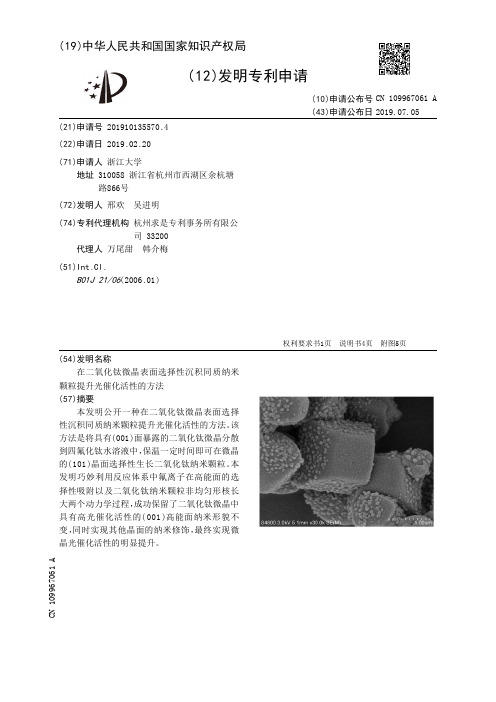
(19)中华人民共和国国家知识产权局(12)发明专利申请(10)申请公布号 (43)申请公布日 (21)申请号 201910135570.4(22)申请日 2019.02.20(71)申请人 浙江大学地址 310058 浙江省杭州市西湖区余杭塘路866号(72)发明人 邢欢 吴进明 (74)专利代理机构 杭州求是专利事务所有限公司 33200代理人 万尾甜 韩介梅(51)Int.Cl.B01J 21/06(2006.01)(54)发明名称在二氧化钛微晶表面选择性沉积同质纳米颗粒提升光催化活性的方法(57)摘要本发明公开一种在二氧化钛微晶表面选择性沉积同质纳米颗粒提升光催化活性的方法。
该方法是将具有(001)面暴露的二氧化钛微晶分散到四氟化钛水溶液中,保温一定时间即可在微晶的(101)晶面选择性生长二氧化钛纳米颗粒。
本发明巧妙利用反应体系中氟离子在高能面的选择性吸附以及二氧化钛纳米颗粒非均匀形核长大两个动力学过程,成功保留了二氧化钛微晶中具有高光催化活性的(001)高能面纳米形貌不变,同时实现其他晶面的纳米修饰,最终实现微晶光催化活性的明显提升。
权利要求书1页 说明书4页 附图5页CN 109967061 A 2019.07.05C N 109967061A权 利 要 求 书1/1页CN 109967061 A1.在二氧化钛微晶表面选择性沉积同质纳米颗粒提升光催化活性的方法,其特征是:使二氧化钛纳米颗粒选择性地在二氧化钛微晶的(101)面沉积,同时使二氧化钛微晶的高能面(001)面保持不变。
2.根据权利要求1所述的在二氧化钛微晶表面选择性沉积同质纳米颗粒提升光催化活性的方法,其特征是:所述的二氧化钛微晶为截角八面体形貌,具有两个(001)高能面和八个(101)面。
3.根据权利要求1所述的在二氧化钛微晶表面选择性沉积同质纳米颗粒提升光催化活性的方法,其特征是:所述的二氧化钛纳米颗粒的粒径为50~80nm。
纳米粒径二氧化钛钛片与人Tenon’S囊成纤维细胞的相容性
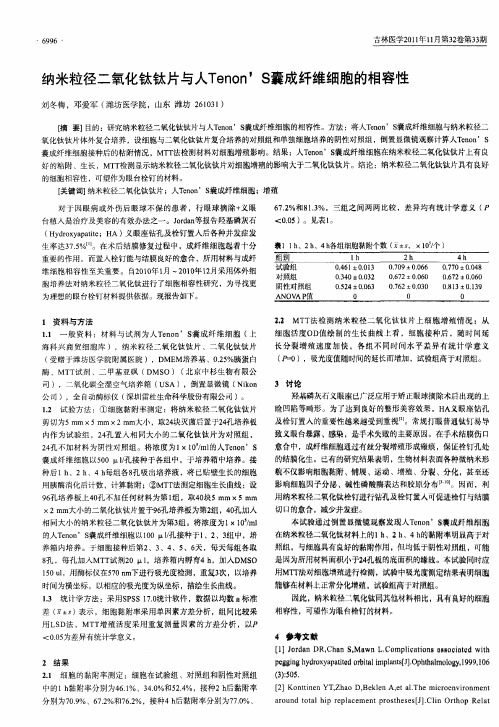
本试验通过倒 置显微镜观察发现人Tnn 囊成纤维细胞 eo ’S 在纳米粒径二氧化钛材料上的1 、2 、 的 4 黏附率明显高于对 h h h 照组 . 与细胞具有 良 好的黏附作用. 但均低于阴性对照组 ,可能 是因为所用材料面积小于2孔板的底面积的缘故 。本试验同时应 4
养箱 内培养。于细胞接种后第2 、4 、6 ,每天每组各取 、3 、5 天
22 MT 法检测纳米粒径二氧化钛钛片上细胞增 殖情 况 :从 . T
海科兴商贸细胞库 ),纳米粒径二氧化钛钛片 、二氧化钛钛片
( 受赠于潍坊医学院附属医院 ),DME M培养基、O 5 . %胰蛋白 2 酶 、MT 试剂 、二甲基亚砜 ( T DMS 0) ( 北京中杉生物有限公
司 ),二 氧化 碳 全湿 空气 培 养箱 ( A)。倒 置显 微 镜 ( k n US Ni o
维细胞相容性至关重要 。自2 1年1 一 0 0 2 0 0 月 2 1 年l月采用体外细
胞培养法对纳米粒径二氧化钛进行了细胞相容性研究,为寻找更
为理想 的 眼 台栓 钉材 料提 供依据 。现报告 如下 。
1 资料与方法 1 一 般资料 :材料与试剂为人T n n 囊成纤维细胞 ( . 1 e o ’S 上
羟基磷灰石义眼座已广泛应用于矫正眼球摘除术后出现的上 睑凹陷等畸形。为了达到 良好 的整形美容效果 ,HA 义眼座钻孔 及栓钉置人的重要性越来越受到重视 。常规打眼普通钛钉易导 ]
剪切为5mm x m 2m 5m x m大小 ,取2块灭菌后置于2孔培养板 4 4 内作 为试验组 ,2 孑 置人相 同大小的二氧化钛钛片为对照组 , 4L
影响细胞 因子分泌 、碱性磷酸酶表达和胶原分布【1。因而,利 0 J 用纳米粒径二氧化钛栓钉进行钻孑及栓钉置人可促进栓钉与结膜 L 切口的愈合 。减少并发症。
金属镍掺杂改进纳米TiO_2的表面增强拉曼散射性能_江欣
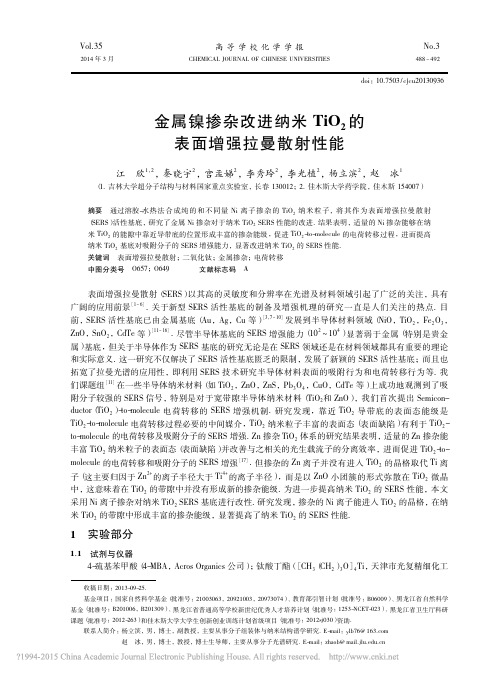
Vol.35
2014 年 3 月
高等学校化学学报
CHEቤተ መጻሕፍቲ ባይዱICAL JOURNAL OF CHINESE UNIVERSITIES
No.3
488 ~ 492
doi: 10.7503 / cjcu20130936
金属镍掺杂改进纳米 TiO2 的 表面增强拉曼散射性能
江
1, 2 2 2 2 2 2 欣 ,秦晓宇 ,宫孟娣 ,李秀玲 ,李光植 ,杨立滨 ,赵
冰
1
( 1. 吉林大学超分子结构与材料国家重点实验室,长春 130012; 2. 佳木斯大学药学院,佳木斯 154007) 摘要 通过溶胶水热法合成纯的和不同量 Ni 离子掺杂的 TiO2 纳米粒子,将其作为表面增强拉曼散射
( SERS) 活性基底,研究了金属 Ni 掺杂对于纳米 TiO2 SERS 性能的改进. 结果表明,适量的 Ni 掺杂能够在纳 tomolecule 的电荷转移过程,进而提高 米 TiO2 的能隙中靠近导带底的位置形成丰富的掺杂能级,促进 TiO2 纳米 TiO2 基底对吸附分子的 SERS 增强能力,显著改进纳米 TiO2 的 SERS 性能. 关键词 表面增强拉曼散射; 二氧化钛; 金属掺杂; 电荷转移 O657; O649 文献标志码 A 中图分类号
ZnO,SnO 2 ,CdTe 等) [11 ~ 16]. 尽管半导体基底的 SERS 增强能力 ( 10 2 ~ 10 4 ) 显著弱于金属 ( 特别是贵金 属) 基底,但关于半导体作为 SERS 基底的研究无论是在 SERS 领域还是在材料领域都具有重要的理论 和实际意义. 这一研究不仅解决了 SERS 活性基底匮乏的限制,发展了新颖的 SERS 活性基底; 而且也 拓宽了拉曼光谱的应用性,即利用 SERS 技术研究半导体材料表面的吸附行为和电荷转移行为等. 我 在一些半导体纳米材料( 如 TiO 2 ,ZnO,ZnS,Pb 3 O 4 ,CuO,CdTe 等 ) 上成功地观测到了吸 附分子较强的 SERS 信号,特别是对于宽带隙半导体纳米材料 ( TiO 2 和 ZnO ) ,我们首次提出 Semicon们课题组 tomolecule 电荷转移的 SERS 增强机制. 研究发现,靠近 TiO 2 导带底的表面态能级是 ductor( TiO 2 ) tomolecule 电荷转移过程必要的中间媒介,TiO 2 纳米粒子丰富的表面态 ( 表面缺陷 ) 有利于 TiO 2 TiO 2 tomolecule 的电荷转移及吸附分子的 SERS 增强. Zn 掺杂 TiO 2 体系的研究结果表明, 适量的 Zn 掺杂能 to丰富 TiO 2 纳米粒子的表面态( 表面缺陷) 并改善与之相关的光生载流子的分离效率 ,进而促进 TiO 2 molecule 的电荷转移和吸附分子的 SERS 增强[17]. 但掺杂的 Zn 离子并没有进入 TiO 2 的晶格取代 Ti 离
- 1、下载文档前请自行甄别文档内容的完整性,平台不提供额外的编辑、内容补充、找答案等附加服务。
- 2、"仅部分预览"的文档,不可在线预览部分如存在完整性等问题,可反馈申请退款(可完整预览的文档不适用该条件!)。
- 3、如文档侵犯您的权益,请联系客服反馈,我们会尽快为您处理(人工客服工作时间:9:00-18:30)。
2. Experimental TiO:(A) was used as recieved (Rizde! de Hahn) after vacuum drying and TiO2(R) was prepared by heating this to 1000°C for 3 h. TiO2(B) was synthesized from K:Ti~O9 according to Marchan, B~ohan and Tournoux [ 1]. However, it proved difficult to stabilize the TiO2(B) modification wi:hout a certain content of K2TisOT, as potassium-free samples were converted to anatase by the dehydration at 500°C. In the present work a sample received from Brohan and Marchand containing only a very small amount of K2TisO7 was used. Characterization of the m~w,~.k hy X-ray p , , , n , ~ diffraction was performed with a Guinier camera. To avoid moisture from the air ~he samples were covered with adhesive tape or mylar film. This coverage preserved the samples, but the quality of the diffraction patterns was somewhat reduced. Also Li insertion tends to broaden the lines of the pattern, possibl7 due to non-equilibrated, strained crystal-
F.vsisk-Kemisk Institut, The Technical University of Denmark, DK-2800 Lyngby, Det 1987
The insertion of Li into the three titanium dioxide modifications, anatase, rutile, and TiO2(B), is studied primarily by electrochemical techniques. At 25°C at potentials above 1.4 V versus Li/LiAsF6,PCthe maximal Li uptake is 0.5 Li/Ti in anatase and TiO.,(B), while rutile does no~ ingert Li. At 120°C utilizing LiCFsSOs/PEO electrolyte an amount of 0.8, 0.5, and 0.5 Li/Ti, respectively, is inserted above 1.3 V. The different behaviour of the chemicallyidentical, but structurally non-equivalent oxides, is discuss~,d.
117 7
liquid organic electrolyte has been obtained [4-11 ]. Up to 0.5 Li/Ti the EMF is constant and beyond this value a steadily declining curve is reported. By powder neutron diffraction on a n-BuLi treated sample Cava and co-workers [ 12,13] have found the Li atoms inserted in half of the empty octahedra, but with each Li being coordinated to five oxygen atoms only. In TiO2(R) Li insertion is curtailed. For the reaction with n-BuLi insertion of 0.03 Li/Ti has been found [ 14], while reports on electrochemical insertion scatter between 0.1 and 1 Li/Ti [4-6,9 ]. For the TiO2(B) modification insertion of 0.85 Li/ Ti by n-BuLi has been reported while discharge of electrochemical cells leads to uptake of 0.8 Li/Ti. NMR investigations suggested the Li atoms to occupy the square pyramidal site at the top and bottom of the open channel when oriented as in fig. 1 [ 1,15 ]. The same site is occupied in the isotypic Li2V3Os [161. In the present work Li insertion in these three titanium dioxides is compared. The investigations are based on chemical lithiation with n-BuLi and on electrochemical measurements on cells with either organic liqUid electrolyte operated at ambient temperature or with polymer electrol~e (120°C).
RNNJ
Fig. 1. The structures of anatase (A), TiO2(B) (B), and ruffle (R) represented by titanium oxygenoctahedra. TiO2(A) is CCP, but the packing is not dense as the crystal class is tetragonal with a c/a ratio of 2.5. The T i - O bonds along the c-axis are, however, not significandy longer than those perpendicular m the caxis leaving the empty octahedra rather large. Lithium insertion has been reported for all three oxides. TiO2(A) consumes 0.6-0.7 Li/Ti by reaction with n-butyiiithium (n-BuLl) [2,3], and electrochemically intercalation of 0.5-1 Li/Ti in cells with
Solid State lonics 28-30 (1988) 1176-1182 North-Holland, Amsterdam
L I T H I U M INSERTION IN D I F F E R E N T TiO., M O D I F I C A T I O N S
B. Z A C H A U - C H R I S T I A N S E N , K. WEST, T. J A C O B S E N and S. A T L U N G
1. Introduction
The various titanium dioxides, anatase, rutile, and TiO2(B), offer chemically identical but structurally non-equivalent h o s t lattices for insertion of lithium atoms. Anatase (TiO2(A)) and rutile (TiO2(R)) are naturally occurring minerals, whereas TiO2 (B) is a synthetic metastable polymorph prepared by soft chemistry [1 ]. When heated to 550°C T i Q ( B ) is transfGrmed "o TiO,(A), which upon further heating is converted to TiO,(R) at 1000°C. In all three oxides titanium is octahedrally coordinated to oxygen, leaving unoccupied sites available for insertion; the different structures represented by TiO6 octahedra are shown in fig. 1. The different packing density of the oxides is reflected by their densities: 3.76 g/cm 3, 3.89 g/cm 3, and 4.25 g/cm 3 for TiO2(B), TiO.~(A), and TiO2(R), respectively. The diffusion path for Li insertion is three-dimensional in TiO2(A), but unidirectional in TiO2(B) and TiO2(R). Due to the ,,',ique primitive tetragonal packing (PTP) of TiO2(R) the empty channels are very narrow; the "'cation radius" of the empty octahedral sites is 0.40 A. The radius of a Li ion varies with coordination but is normally 0.68 ~. The packing of TiO2(B) can be ~egarded as a CCP of oxygen where I of the oxygen atoms are missing. The insertion sites are therefore only 5-coordinated to oxygen. The free radius of the channels is approximately 0.58 A. Also
